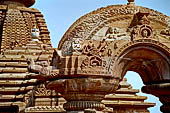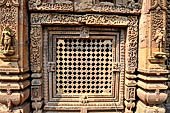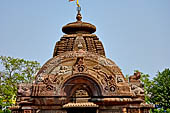The beautifully decorated Mukteswara temple (AD 950) (alternative spelling Mukteshvara Muktesvara) is famous for its torana the magnificent archway unique example of the early Kalinga architecture.
Within the same compound there are various small auxiliary shrines and the less interesting Siddeswara Temple. On the eastern side there is a ritual tank.
Mukteswar Mandir |

|
Dedicated to Shiva the temple consists of only the jagamohan and the deul, surrounded by a low decorated wall that follows closely the temple contour and leaving only a narrow passage. The deul rises only to a height of 11 m, at the time of its construction the colossal structures are not yet attempted. The roof of the jagamohan, in the shape of a truncated pyramid, marks the transition from two tiers to a perfect pyramidal roof.

|
Mukteswar Mandir
|
The freestanding torana has a corbelled architrave made of overlapping layers carefully carved to resemble a true arch. The arch is decorated with reclining maidens, foliage, and heads peeping out of windows. The squat columns are decorated with garlands and fruit; their bases are carved with elephants whose divided bodies meet at the corners.
The side walls of the jagamohan are decorated with miniature shrines, and in the centre by a large lattice window admitting light into the building, surmounted by a large and elaborate pediment overlooked by a ‘flying lion’.
Mukteswar Mandir |

|
The most striking feature of Mukteswara temple are its sculptures.
On the central projection of the deul there is a large bho motif framed by two Indonesian-style guardians, wearing snakes in their hair. Above the bho of the deul south face there is an interesting figure of a dancing Shiva urdhalinga with upper arms is holding a snake, in the suchipada position (one foot touches the ground with only the thumb).

|
Mukteswar Mandir
|
Around the large latticed window on the side of the jagmohana there are nice friezes of lice-picking monkeys. Among other minor carvings images of rearing vyala with a triumphant rider, naginis and surasundari, compositions of human heads with multiple bodies. At the temple entrance panels of Shiva and Parvati with below odd animal figures.
Siddeswara Temple (xi c.) (alternative spelling Sidheswar) is an example of the mature phase of Orissan architecture. It has an image of Ganesh.
Mukteswar Mandir |

|
|
|
|



